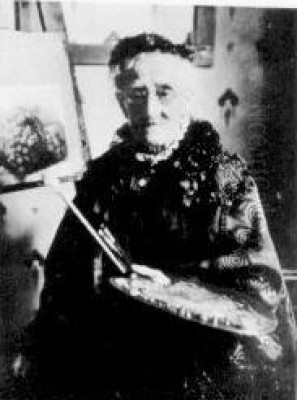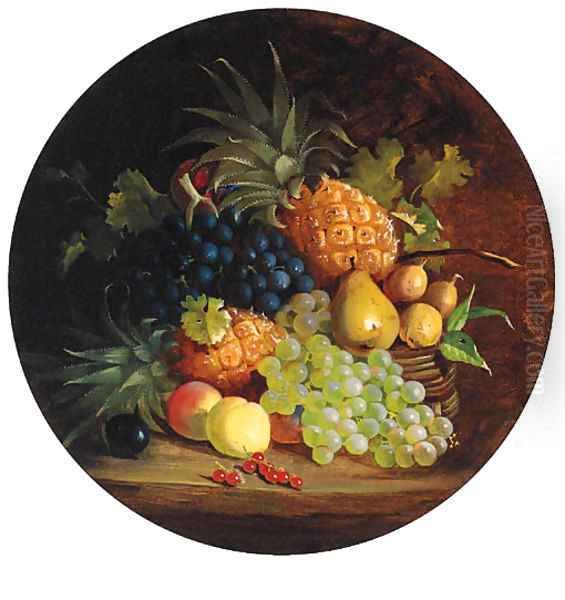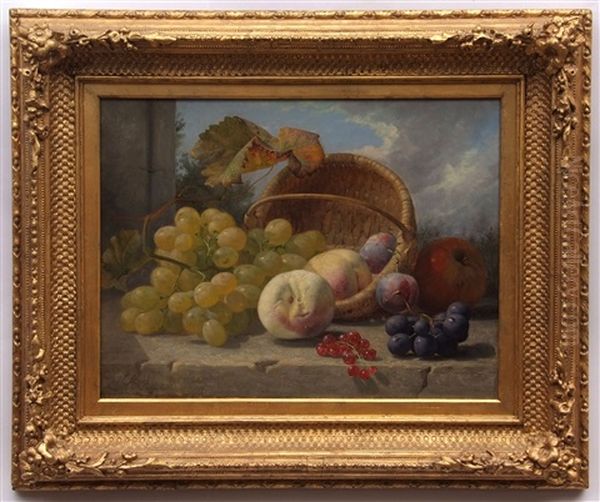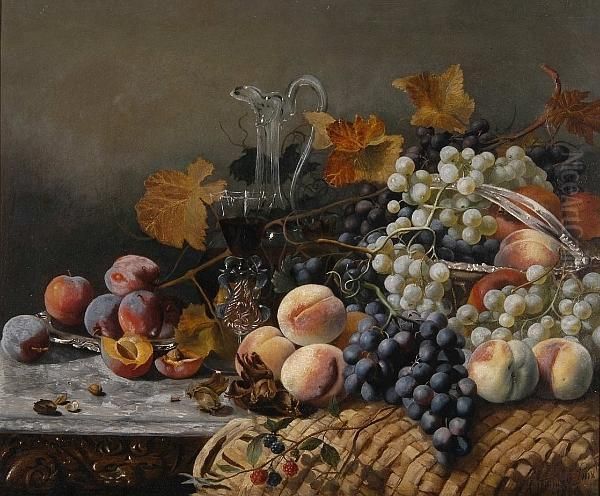Introduction: Norwich's Daughter

Eloise Harriet Stannard, born in Norwich on February 1st, 1829, emerged as one of the most distinguished British still-life painters of the Victorian era. Her long and productive life, ending on February 2nd, 1915, spanned a period of significant change in the art world, yet she remained steadfastly dedicated to the meticulous and luminous depiction of nature's bounty. Rooted in the artistic traditions of her native East Anglia, Stannard carved a unique niche for herself, building upon a rich local heritage while achieving national recognition for her exquisite skill.
Her work is inextricably linked with the Norwich School of Painters, a geographically specific but nationally important movement. Unlike many of her male counterparts in the school who focused on landscape, Stannard, alongside her talented aunt, concentrated on the intimate world of still life, bringing a remarkable vibrancy and precision to the genre. Her paintings, predominantly featuring fruit and flowers, are celebrated for their technical brilliance, clarity of light, and jewel-like finish, echoing the masters of the Dutch Golden Age while possessing a distinctly Victorian sensibility.
The Norwich School Context
To fully appreciate Eloise Stannard's contribution, one must understand the artistic environment from which she emerged. The Norwich School of Painters, flourishing primarily in the first half of the 19th century, was the first provincial art movement of its kind in Britain. Its leading figures, John Crome (1768–1821) and John Sell Cotman (1782–1842), were masters of landscape painting, inspired by the local Norfolk scenery and the Dutch landscape tradition. They established a society, the Norwich Society of Artists, which held annual exhibitions and fostered a strong sense of regional artistic identity.
While landscape dominated the school's output, still life also found skilled practitioners within its ranks. The Stannard family played a crucial role in this aspect of the Norwich tradition. Eloise's father, Alfred Stannard (1806–1889), was a landscape and marine painter associated with the school, and her uncle, Joseph Stannard (1797–1830), was a highly regarded painter of landscapes, marine scenes, and occasional still lifes, known for his fresh, naturalistic approach influenced by Dutch art. This familial immersion in art provided Eloise with an invaluable foundation.

The Norwich School emphasized close observation of nature, directness of technique, and often, a certain quiet intimacy. Though Eloise Stannard's main exhibiting career occurred after the school's initial heyday, her work embodies its principles of careful study and fidelity to subject matter, translated into the realm of still life. She represents a continuation and specialization of the artistic excellence fostered in Norwich.
A Family Steeped in Art: The Stannard Legacy
Artistry ran deep in the Stannard family. Eloise Harriet Stannard was not the only notable female artist in her lineage. Her aunt, Emily Stannard (née Coppin, 1802–1885), wife of Joseph Stannard, was arguably the most celebrated female painter associated with the Norwich School and one of the finest British still-life painters of her generation. Emily was known for her rich, detailed compositions, often featuring game, flowers, and fruit, sometimes presented in elaborate settings.
Emily Stannard's success undoubtedly provided a powerful example and perhaps even informal tutelage for the young Eloise. While their styles differ – Eloise's work often possesses a brighter palette and a crisper, more crystalline light compared to some of Emily's deeper-toned canvases – the shared dedication to the still-life genre and the high level of technical proficiency are evident. They stand together as the pre-eminent female artists of the Norwich School, both specializing in a genre often considered more accessible or appropriate for women artists in the 19th century.
Eloise likely received her primary art education from her father, Alfred Stannard, absorbing the techniques and aesthetics prevalent within their artistic circle. Growing up surrounded by painters, discussions of art, and the tangible presence of canvases and materials would have created an immersive learning environment, fostering her innate talent from an early age.
Artistic Style: Dutch Masters and Victorian Precision
Eloise Harriet Stannard's style is characterized by its remarkable clarity, meticulous detail, and vibrant depiction of texture and light. Her primary influence was the Dutch Golden Age still-life tradition of the 17th century. Artists like Jan Davidsz. de Heem (1606–1684), Willem Kalf (1619–1693), and the renowned female painter Rachel Ruysch (1664–1750) specialized in elaborate compositions ('pronkstilleven') or more focused studies of fruit and flowers, rendered with astonishing realism.

Stannard adopted their precision in depicting surfaces – the fuzzy bloom on a peach, the taut skin of a grape, the delicate translucency of a currant, the intricate weave of a basket. She paid close attention to the play of light, using it to model forms, define textures, and create a sense of depth and atmosphere. Her lighting is often cool and clear, illuminating the objects brightly against typically dark, neutral backgrounds, making the colours of the fruit and flowers appear even more intense and jewel-like.
Unlike some Dutch masters who incorporated symbolic elements (vanitas themes), Stannard's work primarily celebrates the visual beauty and abundance of nature. Her arrangements feel naturalistic, often depicting fruit casually spilling from baskets or arranged simply on a mossy bank or marble ledge. While highly detailed, her paintings avoid appearing overworked or stiff; there is a freshness and immediacy that makes the fruit seem almost tangible. She often included small details like dewdrops or tiny insects, further enhancing the sense of realism, another nod to her Dutch predecessors like Jan van Huysum (1682-1749).
Key Themes and Subjects: Nature's Bounty
Stannard's subject matter remained remarkably consistent throughout her long career: the bounty of the garden and greenhouse. Fruit was her most frequent subject, depicted with extraordinary skill and affection. Grapes, peaches, plums, strawberries, raspberries, gooseberries, and currants appear repeatedly, often shown in simple wicker baskets, on earthenware plates, or tumbling onto surfaces like stone ledges or mossy ground.
She excelled at capturing the specific textures and colours of each fruit variety. Her grapes possess a luminous translucency, her peaches a soft, velvety skin, and her berries a glistening, juicy quality. The arrangements are typically abundant but not overly ostentatious, focusing on the inherent beauty of the forms and colours. The compositions are often centred and balanced, allowing the viewer to appreciate the intricate details of each element.
Flowers also feature prominently, sometimes alone in vases or elaborate epergnes, other times complementing fruit arrangements. Roses, fuchsias, primroses, and geraniums are rendered with the same botanical accuracy and sensitivity to light and texture. Works like Flowers in a Glass Epergne showcase her ability to handle complex reflective surfaces like glass alongside the delicate forms of petals and leaves. Occasionally, she included elements like birds' nests or butterflies, adding points of interest and further enhancing the naturalistic theme.
Representative Works: A Closer Look
Several paintings stand out as representative of Eloise Harriet Stannard's skill and typical subject matter.

Still Life with Grapes and Raspberries Spilling out of a Basket (often dated around 1878, size 41 x 33 cm): This work exemplifies her mastery. A simple wicker basket overflows with luscious green and purple grapes and vibrant red raspberries, tumbling onto a mossy surface below. The detail is exquisite – individual hairs on the raspberries, the subtle bloom on the grapes, the intricate weave of the basket, and the delicate rendering of the moss. The lighting is clear and focused, highlighting the textures and colours against a dark background, creating a sense of contained abundance and tactile reality.
Flowers in a Glass Epergne: While specific dates and dimensions vary for works with this title, they typically show Stannard's skill in depicting both floral arrangements and complex glassware. An epergne, a type of elaborate table centrepiece with multiple holders for flowers or fruit, offered a challenge in rendering transparency, reflections, and the interplay of light through glass and water. Stannard met this challenge admirably, capturing the delicate structure of the epergne alongside the vibrant colours and forms of the flowers it holds.
Redcurrants and Grapes (1864, size 65 x 100 cm): This larger work demonstrates her ability to handle more expansive compositions. It likely features her characteristic subjects – glistening redcurrants, often depicted still on the branch with their delicate leaves, alongside plump grapes. The larger format allows for a more generous arrangement, showcasing her ability to maintain intricate detail across a broader canvas while ensuring a harmonious overall composition.
Other typical titles found in auction records and collections include variations like Still life of Plums, Grapes and Peaches on a Mossy Bank, Still life of Mixed Fruit in a Basket on a Ledge, and Still life with Strawberries in a Cabbage Leaf. These titles reinforce the consistency of her chosen themes and her focus on naturalistic settings and arrangements.
Exhibition History and Recognition
Despite the challenges faced by female artists in the 19th century, Eloise Harriet Stannard achieved considerable recognition during her lifetime. She began exhibiting early, showing her first work at the British Institution in London in 1852. She continued to exhibit there regularly until 1867. Crucially, she also gained acceptance at the prestigious Royal Academy of Arts in London, exhibiting there from 1856 to 1893. This consistent presence at the major London venues indicates the high regard in which her work was held by the art establishment.
In addition to the London exhibitions, she frequently showed her work locally with the Norwich Society of Artists and later iterations of Norwich-based art societies, maintaining her connection to her regional roots. Her paintings were popular with the public and acquired by local patrons. The Art Journal praised her work in 1859, noting her "truthful" and "accurate" rendering of fruit.
Her success is particularly noteworthy given the prevailing attitudes towards women in the art profession. While still life was considered a more acceptable genre for women than, say, large-scale history painting (mastered by contemporaries like Elizabeth Thompson (Lady Butler)), achieving consistent exhibition success at the Royal Academy was still a significant accomplishment. Unlike artists such as Laura Herford, who famously broke barriers for women's admission to the RA Schools, Stannard seems to have navigated the professional exhibition world primarily through the quality and appeal of her work.
Comparison with Contemporaries
Within the specific field of British still-life painting in the mid-to-late 19th century, Eloise Stannard holds a prominent position. Her work can be compared to that of George Lance (1802–1864), who was highly successful with his elaborate, often large-scale fruit compositions, sometimes carrying allegorical overtones in the Dutch tradition. Stannard's work is generally more intimate in scale and less overtly theatrical than Lance's.
Another contemporary was William Henry Hunt (1790–1864), known particularly for his highly detailed watercolours of birds' nests, flowers, and fruit, often characterized by a stippling technique. While both Hunt and Stannard shared an intense focus on naturalistic detail, Stannard worked primarily in oils and generally employed a smoother finish, closer to the Dutch oil painting tradition. William Duffield (1816-1863) was another notable still-life painter, known for dead game as well as fruit, whose career was cut short.
Compared to the broader trends in Victorian art, Stannard's work stands apart from the narrative and symbolic preoccupations of the Pre-Raphaelites like Dante Gabriel Rossetti or John Everett Millais, or the classical subjects favoured by academic painters like Frederic Leighton. Her dedication to still life places her in a lineage focused on observational accuracy and the celebration of natural beauty, a tradition that ran parallel to the more dominant modes of history painting and landscape (like that of the earlier master J.M.W. Turner). Her closest artistic kinship remains with her aunt Emily Stannard and the Dutch masters who inspired them both.
The Victorian Context and Female Artists
Eloise Stannard's career unfolded during the Victorian era, a time of complex and often contradictory attitudes towards women's roles in society and the arts. While Queen Victoria herself was an amateur artist, professional female artists faced significant hurdles. Access to formal art education, particularly life drawing classes, was restricted. Women were often steered towards genres considered less demanding or more 'feminine', such as watercolour painting, portrait miniatures, and, notably, flower and still-life painting.
Within this context, Stannard's specialization in still life can be seen partly as conforming to expectations, yet the sheer quality and professional success she achieved transcended mere convention. She operated as a dedicated professional artist, exhibiting consistently for decades at the highest levels available to her. Her success, alongside that of her aunt Emily and other contemporaries like the figure painter Evelyn De Morgan or the aforementioned Lady Butler, demonstrates that women could and did achieve significant artistic recognition despite the obstacles.
Her focus on the domestic sphere – fruits and flowers from the garden or market – could be interpreted as reflecting the constrained world available to many Victorian women. However, her treatment of these subjects elevates them beyond simple domestic decoration. Through her intense observation and technical virtuosity, she imbued these everyday objects with a sense of wonder and profound beauty, asserting the artistic merit of her chosen genre.
Later Life and Enduring Legacy
Eloise Harriet Stannard continued to paint prolifically throughout her life. She never married and remained based in Norwich, dedicating herself to her art. Her output was considerable, and she maintained a high standard of quality over a career spanning more than sixty years. Her final works continued to explore the subjects she had mastered, demonstrating an enduring fascination with the textures, colours, and forms of fruit and flowers.
She died in Norwich in 1915, having outlived the Victorian era and witnessed the dawn of modernism, though her own style remained firmly rooted in the traditions she embraced early in her career. Today, her work is held in significant public collections, most notably the Norwich Castle Museum & Art Gallery, which has an extensive collection of works by the Norwich School artists, including numerous examples by both Eloise and Emily Stannard. Her paintings also appear regularly on the art market, often commanding strong prices at auction, a testament to her enduring appeal to collectors.
While perhaps not as widely known as the leading male figures of the Norwich School or the major names of Victorian narrative painting, Eloise Harriet Stannard's reputation has steadily grown, particularly with increased scholarly interest in female artists and regional art movements. She is now firmly recognized as one of Britain's foremost still-life painters of the 19th century.
Conclusion: A Master of Luminous Detail
Eloise Harriet Stannard occupies a significant place in the history of British art. As a leading female member of the later Norwich School tradition, she excelled in the genre of still life, creating works of exceptional technical skill, beauty, and clarity. Deeply influenced by the Dutch Golden Age masters yet possessing her own distinct style characterized by bright light and meticulous precision, she captured the lusciousness of fruit and the delicacy of flowers with unparalleled fidelity.
Her ability to gain consistent recognition at major London exhibitions like the Royal Academy and the British Institution, alongside her local prominence in Norwich, speaks volumes about the quality of her work in an era that presented significant challenges for professional women artists. Alongside her aunt Emily Stannard, she ensured that the still-life genre remained a vibrant part of the Norwich artistic legacy. Her paintings continue to delight viewers today with their jewel-like colours, tangible textures, and the quiet, celebratory beauty of nature's bounty, securing her position as a true master of Victorian still life.